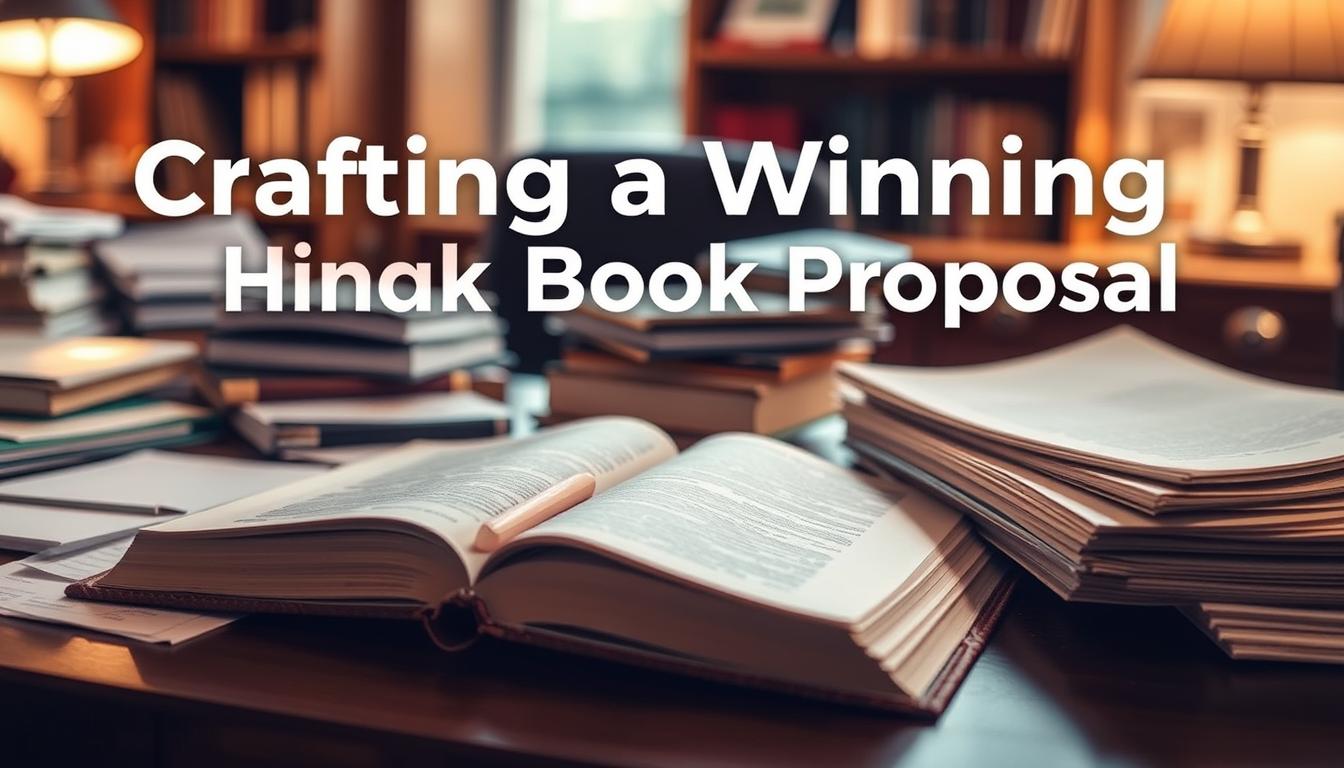Physical Address
304 North Cardinal St.
Dorchester Center, MA 02124
Physical Address
304 North Cardinal St.
Dorchester Center, MA 02124

A book proposal isn’t just paperwork—it’s your golden ticket to grabbing a publisher’s attention. Think of it as a persuasive pitch that answers one critical question: Why does your book deserve a spot on shelves? Unlike fiction, where completed manuscripts often come first, nonfiction authors use proposals to secure deals early, saving time and effort.
Creating a standout proposal requires research, clarity, and strategy. Most range from 10 to 25 pages (double-spaced), excluding sample chapters. Complex projects might stretch longer, especially if including detailed market analysis or supplementary materials. Even if you’ve finished your manuscript, agents or publishers may still request this document to assess its commercial potential.
Your proposal must prove your idea is timely, marketable, and fills a gap. It’s not about what you’re writing—it’s about why it matters to readers. Publishers want confidence in your ability to deliver a product that sells, which means balancing creativity with data-driven insights.
Publishers aren’t just buying your words—they’re investing in a product that sells. A strong book proposal demonstrates your concept’s viability in today’s crowded market. It answers two questions: Who needs this? and Why now?
Nonfiction proposals thrive on clarity and data. Your expertise, platform, and unique angle form the backbone of your pitch. Unlike memoirs, which often lean on narrative voice, these documents prioritize measurable demand.
Consider this: Readers won’t pay for information they can Google. Your proposal must spotlight tangible benefits—like actionable strategies or exclusive research—that free resources can’t match. Agents care less about lyrical prose and more about your ability to reach the right people.
Memoir guidelines vary wildly. Some agents request full manuscripts from debut writers to assess storytelling skills. Established authors, however, might sell memoirs with proposals alone. Nonfiction? It’s all about the case you build.
Self-help or business books hinge on credentials and fresh insights. Memoirs rely on voice and emotional resonance. Know your category’s rules—and bend them only if your concept justifies the risk.
In a sea of similar titles, your book’s success hinges on one critical element: a concept so sharp it cuts through the noise. Flabby ideas drown in today’s crowded market, while focused, fresh angles rise to the top. Your job? Craft a hook that makes agents lean forward, not scroll past.

Generic concepts blend in. Transformative ones switch mindsets. Ask: Does your idea offer a fundamental shift in perspective? Agents crave proposals demonstrating this “switch” effect—not incremental “dial” adjustments.
Research existing titles thoroughly. Identify gaps where your expertise shines. Maybe you’re merging psychology with productivity hacks, or debunking myths with new data. That’s your edge.
Timing matters as much as content. A parenting guide using outdated discipline methods? Dead on arrival. A memoir tackling AI’s impact on modern relationships? Now we’re talking.
Track cultural trends and reader pain points. Publishers want books that solve today’s problems, not rehash yesterday’s solutions. Pair your unique voice with what the market lacks—that’s the sweet spot.
Every successful pitch begins with a blueprint—a roadmap that guides publishers through your vision. While flexibility exists, most book proposals share core sections that build credibility and clarity. Think of it as assembling puzzle pieces: each part must fit seamlessly to reveal the bigger picture.
Start with the title page—your first impression. Include your working title, name, and contact details in a clean format. Next, add a table of contents for the proposal itself. This helps busy editors navigate your document quickly.
The overview acts as your 1–3 page elevator pitch. One literary agent describes it as “the spark that either ignites interest or gets your submission deleted.” Focus on urgency, uniqueness, and audience demand here.
| Core Sections | Purpose | Typical Page Range |
|---|---|---|
| Title Page | Professional introduction | 1 |
| Overview | Highlights commercial appeal | 1–3 |
| Competitive Analysis | Shows market positioning | 2–5 |
| Chapter Summaries | Demonstrates content depth | 10–20 |
Most proposals range from 20–70 pages. They answer four critical questions: What makes your idea exceptional? Why does it matter now? Who will buy it? And why are you the ideal creator? Balance creativity with data—this isn’t art, it’s a business plan with soul.

Your proposal’s success starts long before drafting sections. Imagine trying to build a house without blueprints—it’ll collapse under scrutiny. The same applies here. Focus first on three pillars: concept clarity, market alignment, and an unignorable hook.
Start here:
Agents receive hundreds of pitches weekly. Yours needs to scream “untapped opportunity” within 30 seconds. One editor at a major house admits: “If the hook feels familiar, I stop reading.”
Next, map your concept to current trends. A memoir about overcoming adversity? Highlight how your story intersects with today’s cultural conversations. A business guide? Show data proving demand for your strategies.
Finally, ensure every section reinforces your central message. Your chapter summaries, author bio, and market analysis should all point back to why this project can’t wait. Skip fluff—busy professionals want precision, not poetry.
Think of comparative titles as your book’s neighbors on the shelf—they prove readers already gravitate toward your topic. This analysis isn’t about tearing down competition but showing publishers where your work fits within the market. Start here to refine your concept and avoid months of misdirected effort.
Choose 5–10 recent books your ideal readers actually buy. Focus on titles from established publishers with strong reviews. A parenting guide from Penguin Random House? Better than a self-published eBook with three Amazon ratings.
For each title, note:
Avoid mentioning sales figures. Instead, highlight gaps your book fills. Did those business guides skip remote team strategies? That’s your opening.
Respect the competition while showcasing your unique angle. One agent recalls a client who wrote: “Unlike X’s memoir about grief, my story explores rebuilding identity after loss through community action.” That specificity made publishers take notice.
Never claim “no comparable titles exist.” It signals you haven’t researched your readers’ habits. Even niche topics have related works—academic papers, articles, or podcasts can serve as secondary comps.
For deeper insights, explore this comprehensive guide on structuring standout proposals. Remember: Your goal is to map a clear path between existing books and the unmet need your project satisfies.
Your chapter outline acts as a roadmap—it shows agents how your ideas unfold. For works exceeding 80,000 words, this section proves you’ve structured content thoughtfully. Memoirs thrive on chronological flow, while research-driven projects demand logical progression.
Start with concise summaries. Each entry should spotlight core themes without drowning in details. One agent warns: “Vague chapter descriptions scream ‘unprepared author.’”
| Component | Purpose | Word Range |
|---|---|---|
| Chapter Title | Sets thematic direction | 3–8 |
| Key Points | Highlights core arguments | 50–100 |
| Narrative Arc | Shows progression (memoirs) | 75–150 |
Keep the entire outline under 3,000 words. Complex manuscripts might require deeper dives, but clarity always trumps length.
Choose samples that showcase your best work. Memoirs? Start with the opening scene. For how-to guides, pick the chapter with strongest actionable advice. Avoid introductions—they rarely display your full potential.
Agents want proof you can sustain reader interest. A gripping sample chapter answers unspoken doubts about your ability to deliver. Make every paragraph count.
Who exactly will rush to buy your book? Answering this shapes every decision in your proposal. Publishers need proof you understand your readers’ needs, habits, and unmet desires. Start by visualizing your ideal reader’s daily life—their challenges, goals, and what keeps them up at night.
Your target audience isn’t “everyone.” Narrow it down. A parenting guide might focus on first-time moms juggling remote work. A tech career manual could target mid-level engineers eyeing leadership roles.
Consider these factors:
For example, a memoir about overcoming addiction resonates differently with therapy professionals versus general readers. Use surveys or social media polls to refine your target details. Publishers want specificity—not guesses.
Align this data with current market gaps. If vegan cookbooks flood stores but lack budget-friendly options, position yours as the solution. Your proposal becomes irresistible when audience insights meet unmet demand.